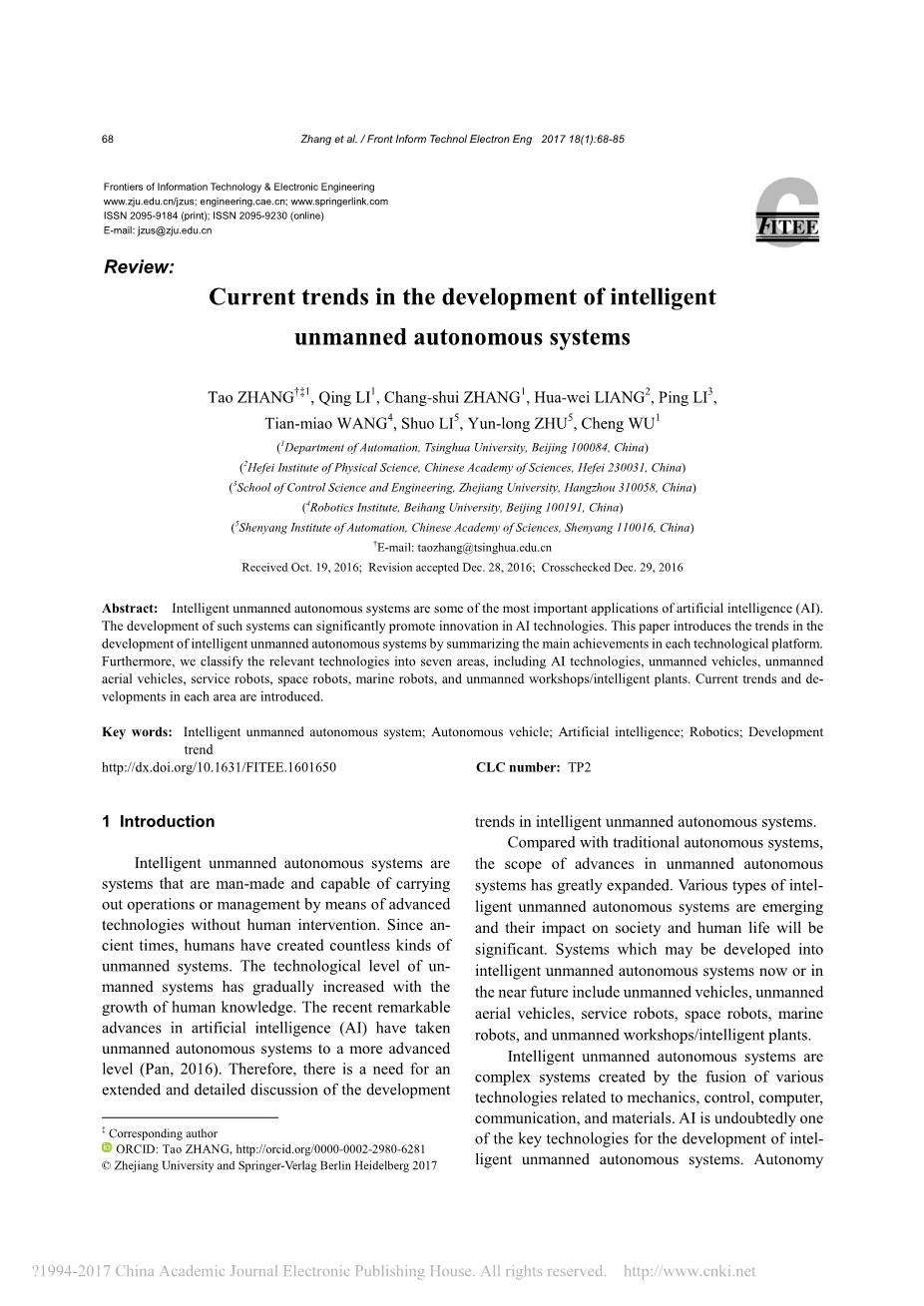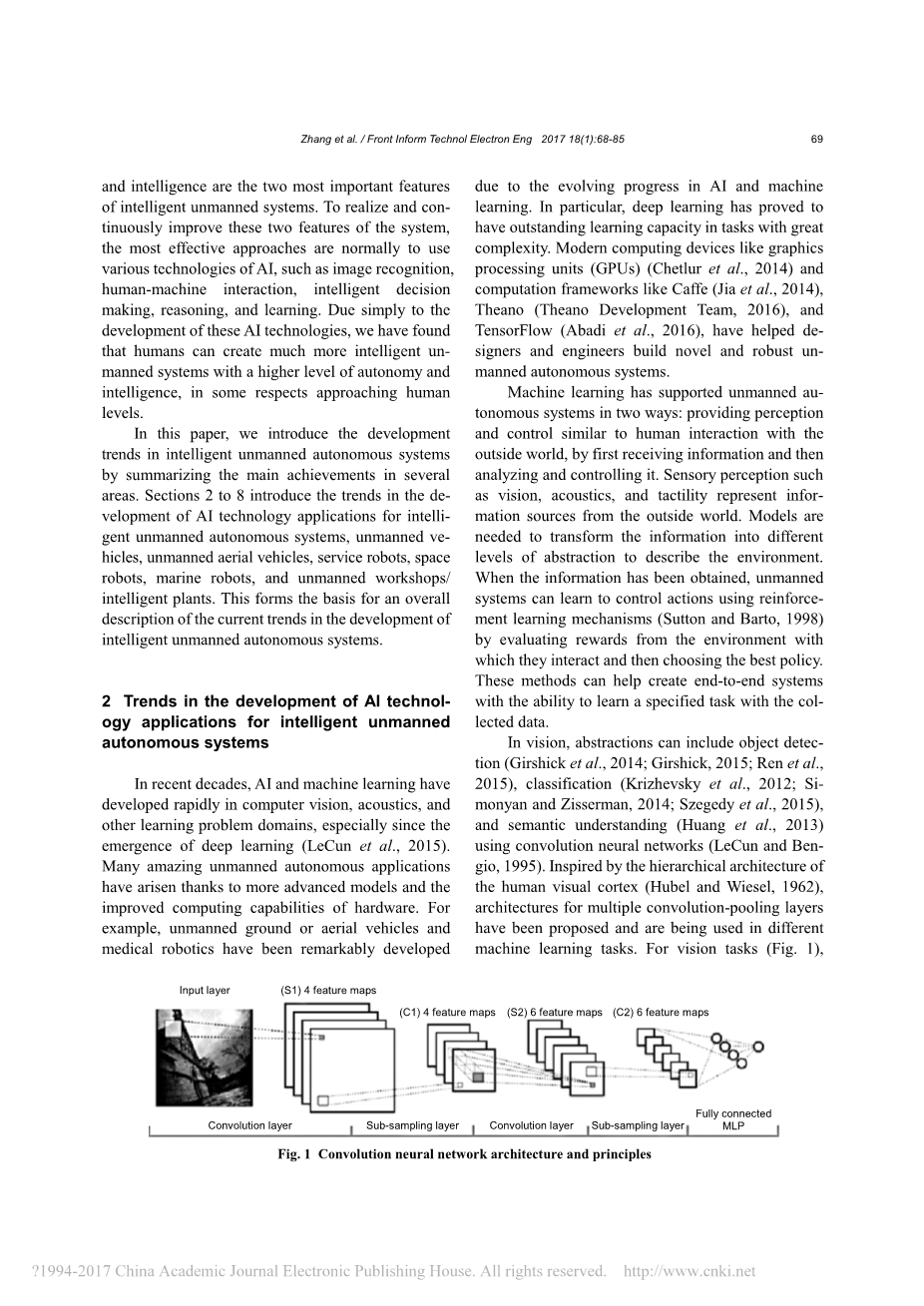智能无人自主系统的发展趋势外文翻译资料
2022-11-05 11:32:41


英语原文共 19 页,剩余内容已隐藏,支付完成后下载完整资料
Current trends in the development of intelligent unmanned autonomous systems
翻译:智能无人自主系统的发展趋势
Abstract: Intelligent unmanned autonomous systems are some of the most important applications of artificial intelligence (AI). The development of such systems can significantly promote innovation in AI technologies. This paper introduces the trends in the development of intelligent unmanned autonomous systems by summarizing the main achievements in each technological platform. Furthermore, we classify the relevant technologies into seven areas, including AI technologies, unmanned vehicles, unmanned aerial vehicles, service robots, space robots, marine robots, and unmanned workshops/intelligent plants. Current trends and developments in each area are introduced.
摘要:智能无人自主控制系统是人工智能最重要的应用之一。这种系统的发展可以显著促进人工智能技术的发展。本文通过总结各技术平台的主要成果,介绍了智能无人自治系统的发展趋势。此外,我们分类介绍了包括人工智能技术、无人驾驶汽车、无人机、服务机器人、空间机器人、海洋机器人、无人车间/智能工厂七个领域的技术应用。C同时介绍了目前各地区智能自主系统技术的趋势和发展。
1 Introduction
1引言
Intelligent unmanned autonomous systems are systems that are man-made and capable of carrying out operations or management by means of advanced technologies without human intervention. Since ancient times, humans have created countless kinds of unmanned systems. The technological level of unmanned systems has gradually increased with the growth of human knowledge. The recent remarkable advances in artificial intelligence (AI) have taken unmanned autonomous systems to a more advanced level (Pan, 2016). Therefore, there is a need for an extended and detailed discussion of the development trends in intelligent unmanned autonomous systems. Compared with traditional autonomous systems, the scope of advances in unmanned autonomous systems has greatly expanded. Various types of intelligent unmanned autonomous systems are emerging and their impact on society and human life will be significant. Systems which may be developed into intelligent unmanned autonomous systems now or in the near future include unmanned vehicles, unmanned aerial vehicles, service robots, space robots, marine robots, and unmanned workshops/intelligent plants.Intelligent unmanned autonomous systems are complex systems created by the fusion of various technologies related to mechanics, control, computer, communication, and materials. AI is undoubtedly one of the key technologies for the development of intelligent unmanned autonomous systems. Autonomy and intelligence are the two most important features of intelligent unmanned systems. To realize and continuously improve these two features of the system, the most effective approaches are normally to use various technologies of AI, such as image recognition, human-machine interaction, intelligent decision making, reasoning, and learning. Due simply to the development of these AI technologies, we have found that humans can create much more intelligent unmanned systems with a higher level of autonomy and intelligence, in some respects approaching human levels.
智能无人系统是人为的和可人为控制的操作或管理的先进技术手段,无需人工干预系统。从古代开始,人类创造了许多种无人控制系统,随着人类知识的提高,无人系统技术的研究水平逐渐提高。 在人工智能领域最近的显著进步是无人自主系统达到了更先进的水平。因此,本文有必要对智能无人自主系统的发展趋势进行详细的叙述和讨论。与传统的自主控制系统相比,无人自主系统的研究应用范围逐渐扩大。各种类型的智能无人自主系统正在出现,对社会和人类的生活产生了显著的影响。在现在或者不久的将来无人自主控制系统可以发展为包括无人驾驶车辆、无人驾驶飞行器、服务机器人、空间机器人、海洋机器人、无人操作车间在内的应用技术。 自主控制系统是由机械、控制、计算机、通讯和材料相关的各种技术融合而成的一项复杂技术。人工智能技术无疑是智能无人自主控制技术发展的关键技术之一 。自主和智能是智能无人系统的两个最重要的特征。为了实现和不断完善这两个系统的特点,最有效的方法是使用人工智能的各种技术,如图像识别、人机交互、智能决策、推理和学习等。随着人工智能技术的发展,人类可以创造出具有较高水平的自主性和智能化自主无人控制系统,在某些方面此技术已经接近人类的水平。
In this paper, we introduce the development trends in intelligent unmanned autonomous systems by summarizing the main achievements in several areas. Sections 2 to 8 introduce the trends in the development of AI technology applications for intelligent unmanned autonomous systems, unmanned vehicles, unmanned aerial vehicles, service robots, space robots, marine robots, and unmanned workshops/ intelligent plants. This forms the basis for an overall description of the current trends in the development of intelligent unmanned autonomous systems.
本文通过总结几个领域的主要成就的方式介绍了智能无人自主系统的发展趋势。第2至第8节介绍了人工智能技术在智能无人系统、无人驾驶汽车、无人机、服务机器人、空间机器人、海洋机器人、无人车间/智能工厂领域应用的发展趋势。这种形式的基础上,本文对智能无人自主系统进行了整体描述以及介绍了目前的发展趋势。
2 Trends in the development of AI technology applications for intelligent unmanned autonomous systems
2.人工智能技术在自主无人系统应用的发展趋势
In recent decades, AI and machine learning have developed rapidly in computer vision, acoustics, and other learning problem domains, especially since the emergence of deep learning . Many amazing unmanned autonomous applications have arisen thanks to more advanced models and the improved computing capabilities of hardware. For example, unmanned ground or aerial vehicles and medical robotics have been remarkably developed due to the evolving progress in AI and machine learning. In particular, deep learning has proved to have outstanding learning capacity in tasks with great complexity. Modern computing devices like graphics processing units and computation frameworks like Caffe , Theano , and TensorFlow , have helped designers and engineers build novel and robust unmanned autonomous systems.
在近些年,人工智能和机器学习在计算机视觉、声学等其他学习领域得到迅猛发展,特别是深度学习的出现。由于更先进的模型和计算机硬件技术的提升出现了许多惊人的无人自主控制系统。例如,由于人工智能和机器学习技术的不断进步,在地面或空中自主机器人和医学机器人技术领域得到了显著提高。特别是,深刻的学习自主技术已被证明在复杂性任务中具有出色的学习能力。像Caffe、Theano等具有图形处理单元和计算框架功能的现代计算设备,有助于设计师和工程师建立新的和强大的无人系统。
Machine learning has supported unmanned autonomous systems in two ways: providing perception and control similar to human interaction with the outside world, by first receiving information and then analyzing and controlling it. Sensory perception such as vision, acoustics, and tactility represent information sources from the outside world. Models are needed to transform the information into different levels of abstraction to describe
剩余内容已隐藏,支付完成后下载完整资料
资料编号:[139991],资料为PDF文档或Word文档,PDF文档可免费转换为Word




